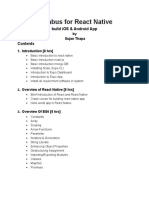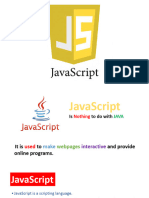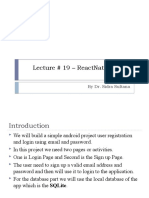0 ratings0% found this document useful (0 votes)
91 viewsLecture # 14 - ReactNative
React Native allows building mobile apps using JavaScript and React. It works by bundling JS, separating UI and logic threads, and communicating between them asynchronously through a bridge. Key differences from web are base components, style using JS objects instead of CSS, and no browser APIs. Core components like View and Text replace div and span. Style is defined with objects and Flexbox is used for layout. Events are handled differently than web. Components can be stateless functions or class components with lifecycles. Expo provides tools to accelerate React Native development.
Uploaded by
Danial AhmadCopyright
© © All Rights Reserved
Available Formats
Download as PPTX, PDF, TXT or read online on Scribd
0 ratings0% found this document useful (0 votes)
91 viewsLecture # 14 - ReactNative
React Native allows building mobile apps using JavaScript and React. It works by bundling JS, separating UI and logic threads, and communicating between them asynchronously through a bridge. Key differences from web are base components, style using JS objects instead of CSS, and no browser APIs. Core components like View and Text replace div and span. Style is defined with objects and Flexbox is used for layout. Events are handled differently than web. Components can be stateless functions or class components with lifecycles. Expo provides tools to accelerate React Native development.
Uploaded by
Danial AhmadCopyright
© © All Rights Reserved
Available Formats
Download as PPTX, PDF, TXT or read online on Scribd
You are on page 1/ 20
Lecture 14: Introduction of React Native
By Dr. Sidra Sultana
Previous Lecture
● Classes
● React
● Imperative vs Declarative Programming
● Props
● State
React Native
● A framework that relies on React core
● Allows us build mobile apps using only JavaScript
○ “Learn once, write anywhere”
● Supports iOS and Android
How does React Native work?
● JavaScript is bundled
○ Transpiled and minified
● Separate threads for UI, layout and JavaScript
● Communicate asynchronously through a “bridge”
○ JS thread will request UI elements to be shown
○ JS thread can be blocked and UI will still work
Differences between RN and Web
● Base components
● Style
● No browser APIs
○ CSS animations, Canvas, SVG, etc.
○ Some have been polyfilled (fetch, timers, console, etc.)
● Navigation
React Native Components
● Not globally in scope like React web components
○ Import from ' r e a c t - n a t i v e '
● div → View
● span → Text
○ All text must be wrapped by a <Text / > tag
● button → Button
● ScrollView
https://facebook.github.io/react-native/docs/components-and-apis.html
Style
● React Native uses JS objects for styling
● Object keys are based on CSS properties
● Flexbox layout
○ Default to column layout
● Lengths are in unitless numbers
● s t y l e prop can take an array of styles
● StyleSheet.create()
○ Functionally the same as creating objects for style
○ Additional optimization: only sends IDs over the bridge
Event Handling
● Unlike web, not every component has every interaction
● Only a few “touchable” components
○ Button
○ TouchableOpacity, TouchableHighlight, TouchableWithoutFeedback
○ TouchableNativeFeedback (Android only)
● Web handlers will receive the event as an argument, but
React Native handlers often receive different arguments
○ Consult the docs
Components
● Return a node (something that can be rendered)
● Represent a discrete piece of the UI
● “All React components must act like pure functions with
respect to their props.”
● Two types:
○ Stateless Functional Component (SFC) a.k.a. Pure Functional
Component
○ React.Component
Stateless Functional Component (SFC)
● Simplest component: use when you don’t need state
● A function that takes props and returns a node
○ Should be “pure” (it should not have any side effects like setting values,
updating arrays, etc.)
● Any change in props will cause the function to be
re-invoked
React.Component
● An abstract class that can be extended to behave
however you want
● These have additional features that SFCs don’t
○ Have instances
○ Maintain their own state
○ Have lifecycle methods (similar to hooks or event handlers) that are
automatically invoked
● Rendering now becomes a function of props and class
properties
Component Lifecycle
Mount Update Unmount
Mount
● const ructor(props)
○ Initialize state or other class properties (bound methods, etc.)
● r e nd er ( )
○ The core of a component
○ Return a node
● componentDidMount()
○ Do anything that isn’t needed for UI (async actions, timers, etc.)
○ Setting state here will cause a re-render before updating the UI
Update
● componentWillReceiveProps(nextProps)
○ Update any state fields that rely on props
● shouldComponentUpdate(nextProps, nextState)
○ Compare changed values, return true if the component should rerender
■ If returned false, the update cycle terminates
○ Almost always a premature optimization
● r e nd er ( )
● componentDidUpdate(prevProps, prevState)
○ Do anything that isn’t needed for UI (network requests, etc.)
Unmount
● componentWillUnmount()
○ Clean up
■ Remove event listeners
■ Invalidate network requests
■ Clear timeouts/intervals
Writing React Native
Expo
● “The fastest way to build an app”
● Suite of tools to accelerate the React Native development
process
○ Snack - runs React Native in the browser
○ XDE - a GUI to serve, share, and publish your Expo projects
○ CLI - a command-line interface to serve, share, and publish projects
○ Client - runs your projects on your phone while developing
○ SDK - bundles and exposes cross-platform libraries and APIs
Import/Export
● Components are great for simplifying code
● We can split components into their own files
○ Helps organize project
○ Export the component from the file
● Import the component before using it in a file
● Default vs named import/export
PropTypes
● React can validate the types of component props at
runtime
● Development tool that allows developers to ensure they’re
passing correct props
● Helps document your components’ APIs
● Only runs in development mode
How to Read Docs
● Have a goal in mind
● See what the library/framework/API offers
● Find something that solves your problem
● Configure using the exposed API
You might also like
- Full Stack Developer - Java-ReactJS-Course ContentNo ratings yetFull Stack Developer - Java-ReactJS-Course Content12 pages
- CSS Animations and Transitions For The Modern WebNo ratings yetCSS Animations and Transitions For The Modern Web322 pages
- Instant Download gRPC Microservices in Go (MEAP V08) Hüseyin Babal PDF All Chapters100% (2)Instant Download gRPC Microservices in Go (MEAP V08) Hüseyin Babal PDF All Chapters47 pages
- Learning Ext JS Fourth Edition - Sample Chapter100% (1)Learning Ext JS Fourth Edition - Sample Chapter30 pages
- 01 Problem Solving and Algorithm DesignNo ratings yet01 Problem Solving and Algorithm Design27 pages
- Mastering C: A Comprehensive Guide to Proficiency in The C Programming LanguageFrom EverandMastering C: A Comprehensive Guide to Proficiency in The C Programming LanguageNo ratings yet
- Object Oriented Javascript: © 2013, Cognizant Technology Solutions100% (1)Object Oriented Javascript: © 2013, Cognizant Technology Solutions29 pages
- Instant download Real World Android by Tutorials Second Edition Professional App Development With Kotlin Raywenderlich Tutorial Team pdf all chapterNo ratings yetInstant download Real World Android by Tutorials Second Edition Professional App Development With Kotlin Raywenderlich Tutorial Team pdf all chapter65 pages
- Rest Servers in Delphi Xe Using DatasnapNo ratings yetRest Servers in Delphi Xe Using Datasnap66 pages
- State Management With React Hooks No Redux or Context Api 8b3035ceecf8No ratings yetState Management With React Hooks No Redux or Context Api 8b3035ceecf817 pages
- Real-Time Rendering 4th Edition Tomas Akenine-MöLler - Instantly access the full ebook content in just a few seconds100% (2)Real-Time Rendering 4th Edition Tomas Akenine-MöLler - Instantly access the full ebook content in just a few seconds70 pages
- Full Download Physically Based Rendering From Theory to Implementation 4th edition Matt Pharr PDF DOCX100% (2)Full Download Physically Based Rendering From Theory to Implementation 4th edition Matt Pharr PDF DOCX50 pages
- Understand JavaScript's "This" With Clarity, and Master It - JavaScript Is SexyNo ratings yetUnderstand JavaScript's "This" With Clarity, and Master It - JavaScript Is Sexy55 pages
- PDF Grokking Functional Programming 1st Edition Michal Plachta Download100% (5)PDF Grokking Functional Programming 1st Edition Michal Plachta Download49 pages
- Learning React Modern Patterns For Developing React Apps 2nd Edition Ebook PDFNo ratings yetLearning React Modern Patterns For Developing React Apps 2nd Edition Ebook PDF42 pages
- RealTime Web Appication Tech History PDFNo ratings yetRealTime Web Appication Tech History PDF45 pages
- Typescript: Typescript Is An Open-Source Programming Language Developed andNo ratings yetTypescript: Typescript Is An Open-Source Programming Language Developed and11 pages
- Hacking With Swift Guide Book 2019-05-29 (PDF)No ratings yetHacking With Swift Guide Book 2019-05-29 (PDF)92 pages
- MERN Projects for Beginners: Create Five Social Web Apps Using MongoDB, Express.js, React, and Node 1st Edition Nabendu Biswas all chapter instant download100% (1)MERN Projects for Beginners: Create Five Social Web Apps Using MongoDB, Express.js, React, and Node 1st Edition Nabendu Biswas all chapter instant download40 pages
- Examples Documentation VPM FAQ Built in V: Advanced TopicsNo ratings yetExamples Documentation VPM FAQ Built in V: Advanced Topics22 pages
- Lecture # 17 - React Native Form Handling: by Dr. Sidra SultanaNo ratings yetLecture # 17 - React Native Form Handling: by Dr. Sidra Sultana21 pages
- Department of Computing: CLO3 (Design & Implement Various Pieces of OS Software)No ratings yetDepartment of Computing: CLO3 (Design & Implement Various Pieces of OS Software)5 pages
- Department of Computing: Lab 12: React Native Login ApplicationNo ratings yetDepartment of Computing: Lab 12: React Native Login Application3 pages
- Department of Computing: CLO4 (Design & Implement Various Pieces of OS Software)No ratings yetDepartment of Computing: CLO4 (Design & Implement Various Pieces of OS Software)3 pages
- Lecture # 19 - Reactnative Login Manager: by Dr. Sidra SultanaNo ratings yetLecture # 19 - Reactnative Login Manager: by Dr. Sidra Sultana37 pages
- Department of Computing: Instructor: Dr. Sidra Sultana Lab Engineer: Ms. Ayesha AsifNo ratings yetDepartment of Computing: Instructor: Dr. Sidra Sultana Lab Engineer: Ms. Ayesha Asif4 pages
- Lecture # 18 - React Native Navigations: by Dr. Sidra SultanaNo ratings yetLecture # 18 - React Native Navigations: by Dr. Sidra Sultana53 pages
- Lecture # 16 - React Native Library To Validate Form FieldsNo ratings yetLecture # 16 - React Native Library To Validate Form Fields13 pages
- Department of Computing: Lab 06: Node - Js MongodbNo ratings yetDepartment of Computing: Lab 06: Node - Js Mongodb4 pages
- Department of Computing: Lab 07: Express JSNo ratings yetDepartment of Computing: Lab 07: Express JS5 pages
- Department of Computing: Lab 5: Node - Js MysqlNo ratings yetDepartment of Computing: Lab 5: Node - Js Mysql4 pages
- Lecture # 13 - React - Part II: Advanced ProgrammingNo ratings yetLecture # 13 - React - Part II: Advanced Programming49 pages
- Lecture # 12 - Introduction To React JSNo ratings yetLecture # 12 - Introduction To React JS76 pages
- Lecture # 5 Introduction To Node - Js (Part II) : by Dr. Sidra SultanaNo ratings yetLecture # 5 Introduction To Node - Js (Part II) : by Dr. Sidra Sultana29 pages
- Lecture # 2 - Introduction To JavascriptNo ratings yetLecture # 2 - Introduction To Javascript38 pages
- CS-213 Advance Programming: Dr. Sidra SultanaNo ratings yetCS-213 Advance Programming: Dr. Sidra Sultana12 pages
- (Ebook) Fullstack Web Components: Complete Guide to Building UI Libraries with Web Components by Steve Belovarich; (edited by) Nate Murray ISBN B0BGYPWQVR - Download the ebook now for an unlimited reading experience100% (3)(Ebook) Fullstack Web Components: Complete Guide to Building UI Libraries with Web Components by Steve Belovarich; (edited by) Nate Murray ISBN B0BGYPWQVR - Download the ebook now for an unlimited reading experience86 pages
- You Don t Know JS ES6 Beyond Kyle Simpson download100% (2)You Don t Know JS ES6 Beyond Kyle Simpson download62 pages
- Flow of Execution in an Angular ApplicationNo ratings yetFlow of Execution in an Angular Application20 pages
- Complete Download You Don t Know JS ES6 Beyond Kyle Simpson PDF All Chapters100% (6)Complete Download You Don t Know JS ES6 Beyond Kyle Simpson PDF All Chapters85 pages
- Beginning Shadow DOM API Get Up and Running - Alex LibbyNo ratings yetBeginning Shadow DOM API Get Up and Running - Alex Libby183 pages
- Full Stack Developer - Java-ReactJS-Course ContentFull Stack Developer - Java-ReactJS-Course Content
- Instant Download gRPC Microservices in Go (MEAP V08) Hüseyin Babal PDF All ChaptersInstant Download gRPC Microservices in Go (MEAP V08) Hüseyin Babal PDF All Chapters
- Mastering C: A Comprehensive Guide to Proficiency in The C Programming LanguageFrom EverandMastering C: A Comprehensive Guide to Proficiency in The C Programming Language
- Object Oriented Javascript: © 2013, Cognizant Technology SolutionsObject Oriented Javascript: © 2013, Cognizant Technology Solutions
- Instant download Real World Android by Tutorials Second Edition Professional App Development With Kotlin Raywenderlich Tutorial Team pdf all chapterInstant download Real World Android by Tutorials Second Edition Professional App Development With Kotlin Raywenderlich Tutorial Team pdf all chapter
- State Management With React Hooks No Redux or Context Api 8b3035ceecf8State Management With React Hooks No Redux or Context Api 8b3035ceecf8
- Real-Time Rendering 4th Edition Tomas Akenine-MöLler - Instantly access the full ebook content in just a few secondsReal-Time Rendering 4th Edition Tomas Akenine-MöLler - Instantly access the full ebook content in just a few seconds
- Full Download Physically Based Rendering From Theory to Implementation 4th edition Matt Pharr PDF DOCXFull Download Physically Based Rendering From Theory to Implementation 4th edition Matt Pharr PDF DOCX
- Understand JavaScript's "This" With Clarity, and Master It - JavaScript Is SexyUnderstand JavaScript's "This" With Clarity, and Master It - JavaScript Is Sexy
- Simultaneous multithreading A Complete GuideFrom EverandSimultaneous multithreading A Complete Guide
- Building Websites with VB.NET and DotNetNuke 4From EverandBuilding Websites with VB.NET and DotNetNuke 4
- PDF Grokking Functional Programming 1st Edition Michal Plachta DownloadPDF Grokking Functional Programming 1st Edition Michal Plachta Download
- Learning React Modern Patterns For Developing React Apps 2nd Edition Ebook PDFLearning React Modern Patterns For Developing React Apps 2nd Edition Ebook PDF
- Typescript: Typescript Is An Open-Source Programming Language Developed andTypescript: Typescript Is An Open-Source Programming Language Developed and
- MERN Projects for Beginners: Create Five Social Web Apps Using MongoDB, Express.js, React, and Node 1st Edition Nabendu Biswas all chapter instant downloadMERN Projects for Beginners: Create Five Social Web Apps Using MongoDB, Express.js, React, and Node 1st Edition Nabendu Biswas all chapter instant download
- Examples Documentation VPM FAQ Built in V: Advanced TopicsExamples Documentation VPM FAQ Built in V: Advanced Topics
- Lecture # 17 - React Native Form Handling: by Dr. Sidra SultanaLecture # 17 - React Native Form Handling: by Dr. Sidra Sultana
- Department of Computing: CLO3 (Design & Implement Various Pieces of OS Software)Department of Computing: CLO3 (Design & Implement Various Pieces of OS Software)
- Department of Computing: Lab 12: React Native Login ApplicationDepartment of Computing: Lab 12: React Native Login Application
- Department of Computing: CLO4 (Design & Implement Various Pieces of OS Software)Department of Computing: CLO4 (Design & Implement Various Pieces of OS Software)
- Lecture # 19 - Reactnative Login Manager: by Dr. Sidra SultanaLecture # 19 - Reactnative Login Manager: by Dr. Sidra Sultana
- Department of Computing: Instructor: Dr. Sidra Sultana Lab Engineer: Ms. Ayesha AsifDepartment of Computing: Instructor: Dr. Sidra Sultana Lab Engineer: Ms. Ayesha Asif
- Lecture # 18 - React Native Navigations: by Dr. Sidra SultanaLecture # 18 - React Native Navigations: by Dr. Sidra Sultana
- Lecture # 16 - React Native Library To Validate Form FieldsLecture # 16 - React Native Library To Validate Form Fields
- Department of Computing: Lab 06: Node - Js MongodbDepartment of Computing: Lab 06: Node - Js Mongodb
- Lecture # 13 - React - Part II: Advanced ProgrammingLecture # 13 - React - Part II: Advanced Programming
- Lecture # 5 Introduction To Node - Js (Part II) : by Dr. Sidra SultanaLecture # 5 Introduction To Node - Js (Part II) : by Dr. Sidra Sultana
- (Ebook) Fullstack Web Components: Complete Guide to Building UI Libraries with Web Components by Steve Belovarich; (edited by) Nate Murray ISBN B0BGYPWQVR - Download the ebook now for an unlimited reading experience(Ebook) Fullstack Web Components: Complete Guide to Building UI Libraries with Web Components by Steve Belovarich; (edited by) Nate Murray ISBN B0BGYPWQVR - Download the ebook now for an unlimited reading experience
- You Don t Know JS ES6 Beyond Kyle Simpson downloadYou Don t Know JS ES6 Beyond Kyle Simpson download
- Complete Download You Don t Know JS ES6 Beyond Kyle Simpson PDF All ChaptersComplete Download You Don t Know JS ES6 Beyond Kyle Simpson PDF All Chapters
- Beginning Shadow DOM API Get Up and Running - Alex LibbyBeginning Shadow DOM API Get Up and Running - Alex Libby
















































































































